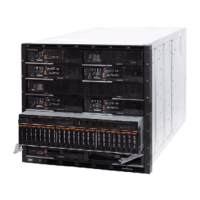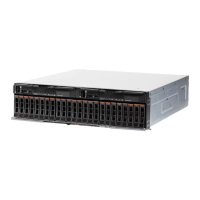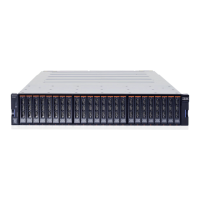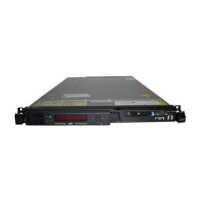Chapter 2. Introduction to IBM Flex System V7000 Storage Node 77
Customers who want to use the global mirror capability with Flex System V7000 on a low
bandwidth link between sites can do so with the use of the low bandwidth remote mirroring.
This capability provides options to help administrators balance network bandwidth
requirements and
recovery point objective (RPO) times for applications, helping reduce
operation costs for disaster recovery solutions. Remote mirroring supports higher RPO times
by allowing the data at the disaster recovery site to get further out of sync with the production
site if the communication link limits replication, and then approaches synchronicity again
when the link is not as busy. This low bandwidth remote mirroring uses space-efficient
FlashCopy targets as sources in remote copy relationships to increase the time allowed to
complete a remote copy data cycle.
See 9.3, “Remote Copy” on page 402 for more information about the Remote Copy services.
For details regarding Remote Copy licensing, see 2.4, “IBM Flex System V7000 Storage
Node licensing” on page 46.
2.7.3 Synchronous / Asynchronous Remote Copy
The general application of Remote Copy seeks to maintain two copies of data. Often, the two
copies are separated by distance, but not always.
The Remote Copy can be maintained in one of two modes: synchronous or asynchronous.
With IBM Flex System V7000 Storage Node, Metro Mirror and Global Mirror are the IBM
branded terms for the functions that are synchronous Remote Copy and asynchronous
Remote Copy.
Synchronous Remote Copy ensures that updates are committed at both the primary and the
secondary before the application considers the updates complete; therefore, the secondary is
fully up to date if it is needed in a failover. However, the application is fully exposed to the
latency and bandwidth limitations of the communication link to the secondary. In a truly
remote situation, this extra latency can have a significant adverse effect on application
performance.
Special configuration guidelines exist for SAN fabrics that are used for data replication. It is
necessary to consider the distance and available bandwidth total network links to determine
the appropriate method to use. See 9.3, “Remote Copy” on page 402 for details on planning,
configuring and using Remote Copy for replication functions.
With the Global Mirror method, there is a design option that assists with low bandwidth for
IBM Flex System V7000 Storage Node and the other IBM virtual storage systems that are
mirroring to it running code level 6.4.x and higher. This option uses change volumes
associated with the primary and secondary volumes. For more details on Remote Copy with
changed volumes, see 9.3.2, “Global Mirror with Change Volumes” on page 409.

